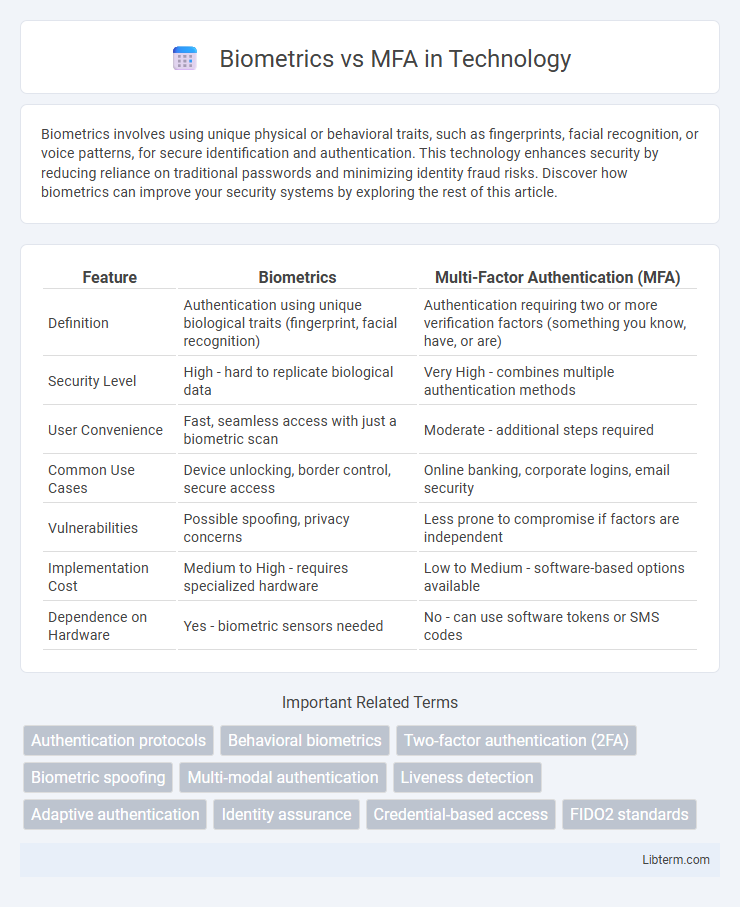Biometrics involves using unique physical or behavioral traits, such as fingerprints, facial recognition, or voice patterns, for secure identification and authentication. This technology enhances security by reducing reliance on traditional passwords and minimizing identity fraud risks. Discover how biometrics can improve your security systems by exploring the rest of this article.
Table of Comparison
| Feature | Biometrics | Multi-Factor Authentication (MFA) |
|---|---|---|
| Definition | Authentication using unique biological traits (fingerprint, facial recognition) | Authentication requiring two or more verification factors (something you know, have, or are) |
| Security Level | High - hard to replicate biological data | Very High - combines multiple authentication methods |
| User Convenience | Fast, seamless access with just a biometric scan | Moderate - additional steps required |
| Common Use Cases | Device unlocking, border control, secure access | Online banking, corporate logins, email security |
| Vulnerabilities | Possible spoofing, privacy concerns | Less prone to compromise if factors are independent |
| Implementation Cost | Medium to High - requires specialized hardware | Low to Medium - software-based options available |
| Dependence on Hardware | Yes - biometric sensors needed | No - can use software tokens or SMS codes |
Introduction to Biometrics and MFA
Biometrics use unique physical or behavioral traits such as fingerprints, facial recognition, or voice patterns for identity verification, providing a highly secure and user-friendly authentication method. Multi-Factor Authentication (MFA) enhances security by combining two or more different authentication factors, including something you know (password), something you have (security token), and something you are (biometric data). Integrating biometrics into MFA strengthens defenses against unauthorized access by adding a robust layer of identity verification based on inherent individual characteristics.
Understanding Biometrics: Definition and Examples
Biometrics refers to the measurement and statistical analysis of people's unique physical and behavioral characteristics, commonly used for identification and access control. Examples include fingerprint recognition, facial recognition, iris scans, and voice recognition, which provide secure and convenient authentication methods. Unlike traditional Multi-Factor Authentication (MFA) that relies on multiple verification steps such as passwords and tokens, biometrics uses inherent personal traits to enhance security and user experience.
Multi-Factor Authentication (MFA): An Overview
Multi-Factor Authentication (MFA) enhances security by requiring users to provide two or more verification factors, such as passwords, security tokens, or biometric data, to gain system access. MFA significantly reduces the risk of unauthorized access compared to single-factor authentication methods by combining something the user knows, has, or is. Biometrics, including fingerprint or facial recognition, serve as one of the authentication factors within MFA frameworks, complementing other elements like PINs or hardware tokens for robust identity verification.
Key Differences Between Biometrics and MFA
Biometrics relies on unique physical or behavioral traits such as fingerprints, facial recognition, or voice patterns for user authentication, offering convenience and difficulty to replicate. Multi-factor authentication (MFA) encompasses a combination of two or more verification methods, including biometrics, passwords, security tokens, or OTPs, enhancing security by layering defenses. The key difference lies in biometrics being a single factor based on intrinsic user attributes, whereas MFA integrates multiple independent factors to reduce the risk of unauthorized access.
Security Strengths: Biometrics vs MFA
Biometrics provide robust security by using unique physical traits such as fingerprints, facial recognition, or iris scans, which are difficult to replicate or steal. Multi-Factor Authentication (MFA) enhances security by requiring two or more independent credentials, often combining something you know (password), something you have (token), and something you are (biometric). While biometrics offer convenience and high accuracy for identity verification, MFA's layered approach significantly reduces the risk of unauthorized access by compensating for weaknesses in single-factor methods.
Usability and User Experience Comparison
Biometrics offer a streamlined user experience by enabling quick, frictionless authentication through fingerprint scans or facial recognition, significantly reducing password fatigue. Multi-factor authentication (MFA) enhances security by requiring multiple verification methods but can introduce additional steps that may disrupt usability and increase authentication time. Balancing ease of use with robust protection, biometric systems excel in user-friendly access, while MFA prioritizes security at the potential cost of convenience.
Privacy Concerns and Data Protection
Biometrics in authentication use unique physical traits like fingerprints or facial recognition, raising significant privacy concerns due to potential misuse or unauthorized access to sensitive personal data. Multi-factor authentication (MFA) enhances security by combining multiple verification methods, reducing reliance on biometric data and mitigating risks associated with data breaches. Strong encryption protocols and strict data protection regulations, such as GDPR, are essential to safeguard biometric information within MFA systems, ensuring user privacy and compliance.
Implementation Challenges of Biometrics and MFA
Biometrics implementation faces challenges related to high initial costs, privacy concerns, and the need for sophisticated hardware capable of accurate biometric data capture. MFA systems require seamless integration across diverse platforms, user compliance, and potential vulnerabilities in secondary authentication methods such as SMS or email codes. Both technologies demand robust security protocols and ongoing maintenance to effectively mitigate risks and ensure reliable user authentication.
Industry Trends and Adoption Rates
Biometrics adoption in security systems has surged, with fingerprint and facial recognition technologies leading the market, driven by increased demand for seamless yet secure user experiences. Multi-factor authentication (MFA) maintains high adoption rates across enterprises, particularly in finance and healthcare sectors, due to stringent regulatory requirements and rising cyber threats. Industry trends reveal a hybrid approach combining biometrics with MFA methods, enhancing authentication accuracy and reducing fraud incidents.
Choosing the Right Authentication: Biometrics or MFA?
Choosing the right authentication method depends on factors such as security level, user convenience, and context of use. Biometrics, leveraging unique physical traits like fingerprints or facial recognition, offer fast, user-friendly access but may face challenges with spoofing and privacy concerns. Multi-Factor Authentication (MFA) combines multiple verification methods, such as passwords, tokens, and biometrics, delivering stronger security by mitigating risks associated with single-factor methods.
Biometrics Infographic

 libterm.com
libterm.com